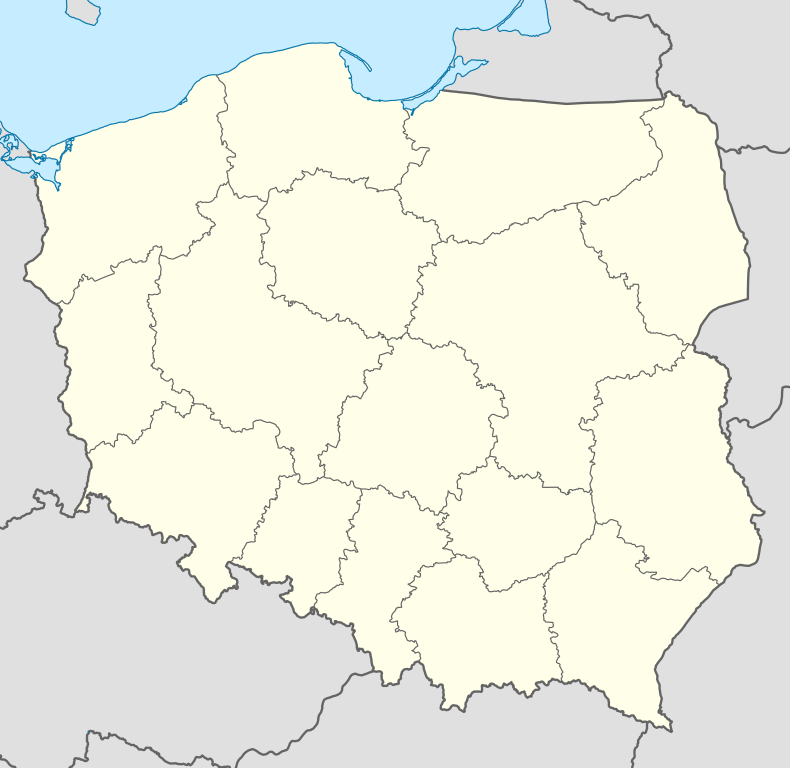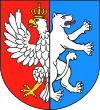Kock
Coordinates: 51°39′N 22°27′E / 51.650°N 22.450°E
| Kock | ||
|---|---|---|
|
Town center | ||
| ||
 Kock | ||
| Coordinates: 51°39′N 22°27′E / 51.650°N 22.450°E | ||
| Country |
| |
| Voivodeship | Lublin | |
| County | Lubartów | |
| Gmina | Kock | |
| Established | 10th century | |
| Town rights | 1417 | |
| Government | ||
| • Mayor | Tomasz Futera | |
| Area | ||
| • Total | 16.78 km2 (6.48 sq mi) | |
| Population (2006) | ||
| • Total | 3,478 | |
| • Density | 210/km2 (540/sq mi) | |
| Time zone | CET (UTC+1) | |
| • Summer (DST) | CEST (UTC+2) | |
| Postal code | 21-150 | |
| Area code(s) | +48 81 | |
| Car plates | LLB | |
| Website | http://kock.pl/ | |
Kock ([kɔt͡sk]) is a town in eastern Poland, about 45 kilometres (28 miles) north of Lublin and 120 kilometres (75 miles) south-east of Warsaw. It lies in Lublin Voivodeship, in Lubartów County. It is the capital of the administrative district Gmina Kock. Historically Kock belongs to the Polish province of Lesser Poland and is located in its northeastern corner. As of 2004, its population numbered 3,509.
Name and location
Kock is located a few kilometers north of the Wieprz river, approximately 150 meters above sea level, near the Łuków Lowland (Równina Łukowska). In 1952–1954 it was the seat of Gmina Białobrzegi. The town first appears in chronicles in 1258 as Cocsk. In the 15th century, it was called Kocsko or Koczsko, and in 1787, its name was spelled Kocko. Current form has been in use since the 19th century, and the word Kock either comes from the nast name or a nickname Kot (a person named so founded the town), or from a plant called kocanka (Helichrysum arenarium), which grows abundantly in the area.
History
Kock has been recognized as an established community since the 12th century. It received its city charter in 1417, by King Władysław II Jagiełło, who granted the charter upon request of Jakub, the Bishop of Płock. In 1518 the town belonged to Mikolaj Firlej, Crown Hetman and the Voivode of Sandomierz. The Firlej family owned Kock until the second half of the 18th century, and at that time the town became an important center of the Protestant Reformation in Lesser Poland. Around the year 1750 Kock passed into the hands of Princess Anna Jabłonowska of the Sapieha family, who invested a lot of money and energy into the town, ordering the construction of a town hall, a palace and a church. Furthermore, she established the market square (or rynek). The residents of the town participated in the January Uprising, for which the Russians deprived Kock of its town rights (1870, recovered in 1915). Several important battles took place at Kock in the 19th and early 20th centuries:
- Battle of Kock (1809), May 5, 1809, during the Polish–Austrian War,
- 17–20 June 1831, and September 12, 1831 during the November Uprising,
- December 25, 1863, during the January Uprising,
- Battle of Kock (1920), August 14–16, 1920, during the Polish–Soviet War,
- Battle of Kock (1939), October 2–6, 1939, during the Polish September Campaign,
- August 1944, during the Operation Tempest.
After World War I Kock belonged to Lublin Voivodeship. The town, located away from rail connections, stagnated. Furthermore, in 1927 large parts of it burned in a fire. Kock was one of centers of the Home Army, whose units (27th Volhynian Home Army Infantry Division freed the town on July 22, 1944. Afterwards, the Soviets disbanded Polish soldiers, and in the resulting civil war, Kock was captured by anti-Communist resistance (May 1, 1945).
Points of interest
- Parish Church (1779–82),
- The House of Jozef Morgensztern (see Menachem Mendel of Kotzk),
- Jewish cemetery (18th century),
- Military cemetery with the grave of General Franciszek Kleeberg,
- Classicistic Palace of Princess Anna Jablonowska (1770).
Jews of Kock
In the 17th century, a Jewish community was established in the town. In Yiddish, the community is known as Kotzk or Kotsk. In the 19th century, it became an important centre of Hasidism as the longtime home of Rabbi Menachem Mendel of Kotzk, the Kotzker rebbe who established the Kotsk dynasty. Most of the Jews were murdered by the Nazis in the Holocaust during the occupation of Poland (1939–1945), and a Jewish community has not been reestablished since the war.
-

Kock in 18th century
-

Town center
-

Street
External links
| Wikimedia Commons has media related to Kock. |
| ||||||||||||||||||||
| ||||||||||||


